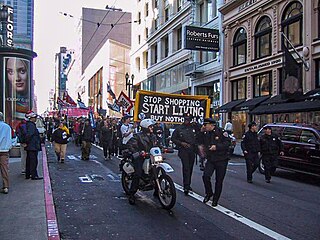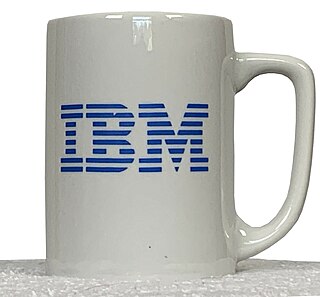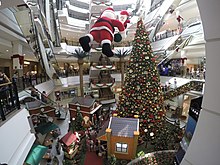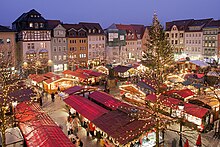
Boxing Day is a holiday celebrated after Christmas Day, occurring on the second day of Christmastide. Boxing Day was once a day to donate gifts to those in need, but it has evolved to become a part of Christmas festivities, with many people choosing to shop for deals on Boxing Day. It originated in the United Kingdom and is celebrated in several Commonwealth nations. The attached bank holiday or public holiday may take place on 28 December if necessary to ensure it falls on a weekday. Boxing Day is also concurrent with the Christian festival Saint Stephen's Day.

Shopping is an activity in which a customer browses the available goods or services presented by one or more retailers with the potential intent to purchase a suitable selection of them. A typology of shopper types has been developed by scholars which identifies one group of shoppers as recreational shoppers, that is, those who enjoy shopping and view it as a leisure activity.

Buy Nothing Day is a day of protest against consumerism. In North America, the United Kingdom, Finland and Sweden, Buy Nothing Day is held the day after U.S. Thanksgiving, concurrent with Black Friday; elsewhere, it is held the following day, which is the last Saturday in November.

Black Friday is the Friday after Thanksgiving in the United States. It traditionally marks the start of the Christmas shopping season in the United States. Many stores offer highly promoted sales at discounted prices and often open early, sometimes as early as midnight or even on Thanksgiving. Some stores' sales continue to Monday or for a week.

In the United States, public holidays are set by federal, state, and local governments and are often observed by closing government offices or giving government employees paid time off. The federal government does not require any private business to close or offer paid time off, as is the case for most state local governments, so employers determine which holidays to observe.

Merchandising is any practice which contributes to the sale of products to a retail consumer. At a retail in-store level, merchandising refers to displaying products that are for sale in a creative way that entices customers to purchase more items or products.

Montgomery Ward is the name of two successive U.S. retail corporations. The original Montgomery Ward & Co. was a world-pioneering mail-order business and later a leading department store chain that operated between 1872 and 2001. The current Montgomery Ward Inc. is a national online shopping and mail-order catalog retailer that started several years after the original Montgomery Ward shut down.
Cyber Monday is a marketing term for e-commerce transactions on the Monday after Thanksgiving in the United States. It was created by retailers to encourage people to shop online. The term was coined by Ellen Davis of the National Retail Federation and Scott Silverman, and made its debut on November 28, 2005, in a Shop.org press release entitled "Cyber Monday Quickly Becoming One of the Biggest Online Shopping Days of the Year". Cyber Monday takes place the Monday after Thanksgiving; the date falls between November 26 and December 2, depending on the year.

Christmas creep is a merchandising phenomenon in which merchants and retailers introduce Christmas-themed merchandise or decorations before the traditional start of the holiday shopping season, which in the United States is on the day after Thanksgiving. The term was first used in the mid-1980s.
K·B Toys was an American chain of mall-based retail toy stores. The company was founded in 1922 as Kaufman Brothers, a wholesale candy store. The company opened a wholesale toy store in 1946, and ended its candy wholesales two years later to emphasize its toy products. Retail sales began during the 1970s, using the name Kay-Bee Toy & Hobby.

The Christmas season or the festive season; also known as the holiday season or the holidays, is an annual period generally spanning from late November to early January. Incorporating Christmas Day and New Year's Day, the various celebrations during this time create a peak season for the retail sector extending to the end of the period. Christmas window displays and Christmas tree lighting ceremonies are customary traditions in various locales.

Talkboy is a line of handheld voice recorder and sound novelty toys manufactured by Tiger Electronics in the 1990s. The brand began as a result of a promotional tie-in with the 1992 film Home Alone 2: Lost in New York; the most well-known product was the Deluxe Talkboy, a cassette recorder and player with a variable-speed voice changer that caused toy crazes over several holiday shopping seasons beginning in 1993.

Thanksgiving is a federal holiday in the United States celebrated on the fourth Thursday of November. It is sometimes called American Thanksgiving to distinguish it from the Canadian holiday of the same name and related celebrations in other regions. It originated as a day of thanksgiving and harvest festival, with the theme of the holiday revolving around giving thanks and the centerpiece of celebrations remaining a Thanksgiving dinner. The dinner traditionally consists of foods indigenous to the Americas: turkey, potatoes, squash, corn (maize), green beans, cranberries, and pumpkin pie. Other Thanksgiving customs include charitable organizations offering thanksgiving dinner for the poor, attending religious services, and watching television events such as Macy's Thanksgiving Day Parade and America's Thanksgiving Parade as well as NFL football games. Thanksgiving is regarded as the beginning of the holiday season, with the day following it, Black Friday, said to be the busiest shopping day of the year in the United States.
In retail, a doorbuster or door crasher deal is an offer that is handed out early into the business's opening hours; this offer almost always is promoting a good in limited supply. These deals are designed to attract large numbers of shoppers into the business.
Super Saturday or Panic Saturday is the last Saturday before Christmas or Christmas Eve, and is a major day of revenue for American retailers, marking the end of the shopping season which begins on Black Friday. Super Saturday targets last-minute shoppers. Typically the day is ridden with one-day sales in an effort to accrue more revenue than any other day in the Christmas and holiday season. The date is slightly more likely to fall on December 22, 19, or 17, than on December 21 or 20 (57), and slightly less likely to occur on December 23 or 18 (56). On years when Christmas falls on a Sunday, Super Saturday is officially on December 17 instead of December 24 even though the last Saturday before Christmas is December 24.
Cyber Black Friday is a marketing term for the online version of Black Friday, the day after Thanksgiving Day in the United States. The term made its debut in a 2009 press release entitled "Black Friday Goes Online for Cyber Black Friday". According to TechCrunch, there was $9 billion in online sales on Cyber Black Friday, which is up 21.6% from 2019. With this, the average cart-size for a shopper was $95.60, and Shopify noted that there was an average of $6.3 million spent per minute across their more than one million merchant platform. A lot of this spending was directed towards technological devices, primarily smart phones. Of the $9 billion is sales, $3.6 billion (40%) was for smart phones. However, Cyber Black Friday is still inferior to its sister, Cyber Monday. Cyber Monday is primarily known to offer more discounted items, and is projected to reach sales between $11.2 billion and $13 billion in 2020. On a more promising no†e, Gian Fulgoni of comScore said, "Black Friday, better known as a shopping bonanza in brick-and-mortar retail stores, is increasingly becoming one of the landmark days in the online holiday shopping world." Some Cyber Black Friday sales are short-lived, last through the weekend, into Cyber Monday, and beyond.

Small Business Saturday is a marketing initiative created and promoted by American Express to encourage holiday shopping on the Saturday after Thanksgiving in the United States, during one of the busiest shopping periods of the year. This Saturday is always the last one in November, so it falls between November 24 and November 30.

A Christmas gift or Christmas present is a gift given in celebration of Christmas. Christmas gifts are often exchanged on Christmas Eve, Christmas Day itself or on the last day of the twelve-day Christmas season, Twelfth Night. The practice of giving gifts during Christmastide, according to Christian tradition, is symbolic of the presentation of the gifts by the Three Wise Men to the infant Jesus.

The COVID-19 pandemic has taken a sharp economic toll on the retail industry worldwide as many retailers and shopping centers were forced to shut down for months due to mandated stay-at-home orders. As a result of these closures, online retailers received a major boost in sales as customers looked for alternative ways to shop and the effects of the retail apocalypse were exacerbated. A number of notable retailers filed for bankruptcy including Ascena Retail Group, Debenhams, Arcadia Group, Brooks Brothers, GNC, J. C. Penney, Lord & Taylor and Neiman Marcus.
The Black Friday hoax is historical claim about the origin of the term "Black Friday." The term denotes the Friday after Thanksgiving in the United States, a day that traditionally marks the start of the Christmas shopping season.


















